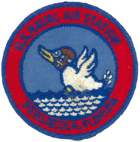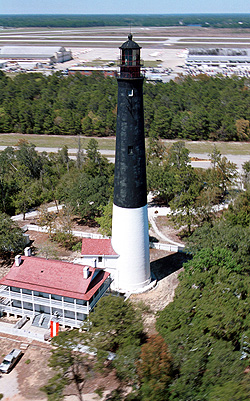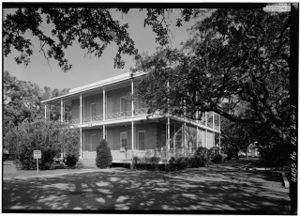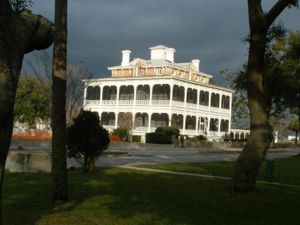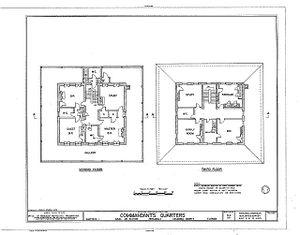Naval Air Station Pensacola
| Naval Air Station Pensacola Forrest Sherman Field | |||
|---|---|---|---|
| IATA: NPA - ICAO: KNPA - FAA: NPA | |||
| Summary | |||
| Controlled By | United States Navy | ||
| Facility Type | Naval Air Station | ||
| Location | Pensacola, Florida | ||
| Commissioned | 1913 | ||
| Current Status | Active | ||
| Commanding Officer | Captain Peter S. Frano | ||
| Elevation AMSL | 28 ft (8.5 m) | ||
| Coordinates | |||
| Runways | |||
| Direction | Length | Surface | |
| ft | m | ||
| 01/19 | 7,137 | 2,175 | Asphalt/Concrete |
| 07L/25R | 8,002 | 2,439 | Asphalt/Concrete |
| 07R/25L | 8,001 | 2,439 | Asphalt/Concrete |
Naval Air Station Pensacola or NAS Pensacola (IATA: NPA, ICAO: KNPA, FAA LID: NPA), "The Cradle of Naval Aviation", is a United States Navy base located in Warrington, a community southwest of the Pensacola city limits. It is best known as the primary training base for Navy and Marine aviators and as the home base for the Blue Angels precision-flying team.
NAS Pensacola contains Forrest Sherman Field , home of Training Air Wing Six which includes the Training Squadron 4 Warbucks, Training Squadron 10 Wildcats and Training Squadron 86 Sabrehawks squadrons (flying T-2 Buckeye, T-6A Texan II, T-39 Sabreliner and T-1A Jayhawk aircraft), the Blue Angels Navy Flight Demonstration Squadron (flying F/A-18 Hornets), the 2nd German Air Force Training Squadron USA and the NAS Pensacola Search and Rescue detachment (flying UH-3H Sea King helicopters). A total of 131 aircraft operate out of Sherman Field generating 110,000 flight operations each year.
The National Museum of Naval Aviation, the Pensacola Naval Air Station Historic District, and historic Fort Barrancas are all located on the grounds of NAS Pensacola.
Contents
History[edit]
The site now occupied by NAS Pensacola has a colorful background dating back to the 16th century when Spanish explorer Don Tristan de Luna founded a colony on the bluff where Fort Barrancas is now situated.
[edit]
Realizing the advantages of the Pensacola harbor and the large timber reserves nearby for shipbuilding, in 1825 President John Quincy Adams and Secretary of the Navy Samuel Southard made arrangements to build a Navy yard on the southern tip of Escambia County, where the air station is today. Navy Captains William Bainbridge, Lewis Warrington, and James Biddle selected the site on Pensacola Bay.
Construction began in April 1826, and the Pensacola Navy Yard soon became one of the best equipped naval stations in the country. In its early years the base dealt mainly with the suppression of slave trade and piracy in the Gulf of Mexico and Caribbean Sea.
In the Civil War, when New Orleans was captured by Union forces in 1862, Confederate troops, fearing attack from the west, retreated from the Navy Yard and reduced most of the facilities to rubble.
After the war, the ruins at the yard were cleared away and work was begun to rebuild the base. Many of the present structures on the air station were built during this period, including the stately two- and three-story houses on North Avenue. Many of these newly rebuilt structures were destroyed by the great hurricane of 1906 and the resulting storm surge.
North Avenue[edit]
North Avenue has 5 homes built upon it which are still standing today. These home were all built in the 1870s and many of them are still in use today. All of these homes are used for various Marine and Naval Officers and their families as long as the officer is at least an O-6, or Captain. The first two homes as you approach North Avenue from the west, heading east, are two story homes occupied by various officers. The next three, two story homes are currently being used as conference centers. Unfortunately in 2004 after Hurricane Ivan destroyed the inside of many homes on base, the Navy did not have enough funds to repair the homes to housing status. So in order to keep the homes and not let them come to complete ruin, the Navy appropriated funds to turn them into conference centers. At the end of North Avenue is Quarerts A.
Quarters A, North Avenue[edit]
Currently there are numerous homes left on North Avenue, as well as a unique octagonal structure that is the only totally surviving building of the burnings from the Civil War. It was spared burning from the Armies due to its state as a Naval Chapel, however, its basement did serve as an armory. Today it is one of the legal offices for the Navy. Across Central Ave ( a brick walk-way, closed to traffic, that is perpendicular to North Ave) and buried amongst 200 plus year old oak trees, is a large two story building that served as the Commandant's Offices.
Today it is used as the VIP Visiting Officer Quarters, and has held many dignified guests including President George Bush and various other visiting Heads of State, both international and domestic.
If one heads North along Central Avenue you will most certainly notice a very distiguished, very stately, three story home that is referred to as Quarters A. Originally built to hold the Commandant and his family, this 3 story, eight bedroom home covers just above 8,000 square feet and is stockpiled with history. As you enter the home you are met by a large screened-in porch, very southern in style and very functional in use. You are greeted by a pair of large, double doors made of wood that have the feeling of history in their grains. If you are lucky enough to have come this far, you enter in through these doors to a grand foyer, 18 foot high ceiling throughout the home and wooden floors complete the grandeur.
To your right is a lavishly decorated parlor with a large granite fireplace and beautiful furniture that is part of the home. Across the foyer in a large living room with once again a fire place and a small niche, which makes a perfect area for an upright piano. Back into the foyer, heading deeper into the house to the right, pass the parlor is a large dining room with a table as old as the home (circa 1870s) with original chairs stuffed with horse hair. Another niche is found in this room which usually (many small details depend on the family and its needs) a small dining table used for family dinners or for a buffet. Another fireplace is found in this room.
Another specialty of this home is that all the fireplaces are made of a different type of granite from around the world. At the very north end of the dining room is a large kitchen that, in southern style, looks somewhat detatched from the home. (This actually is a southern trademark of an older home. The kitchen was kept further, if not totally detatched from the house to keep the majority of the servants out of view and also a safety factor in case the kitchen caught fire). If one walks around a large staircase that rises to the second floor you enter in to what is commonly used as a family room with a sun room that looks over the back yard. The upstairs is set up in a very general way. Because the home never is occupied for a long amount of time (5 years on average) by the same family, each family sets up the house differently. Ascending up the first flight of stairs, from the foyer, you stop at a landing which also has a bathroom. Step further into the landing, prior to reaching the bathroom and their are two sets of stairs that go down into the kitchen and up onto the third floor. These stairs were built for use of servants. A smaller set of stairs completes the journey to the second floor. As you reach the second floor there are four main rooms present. Two rooms on either side of a hall way, with a bathroom at the very end of the hall away from the stairs. Each of the two rooms on either side, are connected by a hallway. The two rooms on the right are connected by a bathroom and are usually used as bedrooms or one bedroom and a leisure room. Once again, depending on the needs of the family. Across the hall contains the master bedroom and a room which is usually used as the Admirals personal office. Climbing another set of double stairs to the third floor reveals a set of four more bedrooms and also a large closet space in between two of the bedrooms. In the large space between the bedroom there is a stair case which leads to a cupola. THere is a famous story with this cupola and it gives the house significant interest. As the story goes, Commodore Melanchton B. Woolsey was the first commandant to live here. He was terrified of contracting yellow fever, since an epidemic had already claimed thousands of lives and he didn't want to be the disease's next victim. He erroneously believed, as others did also, that disease carrying mosquitoes could only fly a few feet high. So, Woolsey moved into the third-story cupola. He got his meals, rum (which he claimed was a "tonic" against the fever) and tobacco for his pipe by lowering a basket on a rope from one of the cupola's windows. One day his servant forgot the rum! Woolsey died soon thereafter. As all residents of Quarters "A" know, his spirit stayed on in the house. Perhaps it is to stay with a lovely lady, transparent and clad in white, who also resides in Quarters "A", forever.
The grounds of Quarters A are very simple for the home's status. Along North Avenue and to the West of the home but to the South of the kitchen is a pond with a trellace that grows both roses on one side and wisteria on the other. Along with various other species of flora including gardenias, hibiscus, various roses, and large elephant ears. Behind the home looking towards the large wall (which on the other sides holds Chevalier Field) on either side are two large buildings that are used as storage sheds. Around the time the home was orignially built they held the horses and carriages for the Commandant. In the center of the yard a large fountain is held with four walkways going towards all the cardinal directions. Due to various storms, families and changes in landscaping the yard is ever changing.
The home currently is home to the Commander of Naval Education Training Command who is the senior Naval Officer on NAS Pensacola. Usually he or she is an Admiral, but in the past 50 years the rank has never fallen below a Captain. Amongst some of the more famous naval officers to have lived in Quarters A include Admiral Chester Nimitz, Admiral Halsey, Admiral A.C. Read, Admiral John H. Fetterman, and Rear Admiral Joseph Kilkenny.
--Admiral 22:53, 2 June 2008 (CDT)
[edit]
Meanwhile, great strides were being made in aviation. The Wright Brothers and especially Glenn Curtiss were trying to prove to the Navy that the aircraft had a place in the fleet. The first aircraft carrier was built in January 1911, and a few weeks later, the seaplane made its first appearance. Then, civilian pilot Eugene Ely landed a frail craft aboard USS Pennsylvania (ACR-4) in San Francisco Bay, and the value of the aircraft to the Navy had been demonstrated.
The Navy Dept., now awakened to the possibilities of Naval Aviation through the efforts of Capt. Washington Irving Chambers, prevailed upon Congress to include in the Naval Appropriation Act enacted in 1911–12 a provision for aeronautical development. Chambers was ordered to devote all of his time to naval aviation.
In October 1913, Secretary of the Navy Josephus Daniels, appointed a board, with Capt. Chambers as chairman, to make a survey of aeronautical needs and to establish a policy to guide future development. One of the board's most important recommendations was the establishment of an aviation training station in Pensacola.
Upon entry into World War I, Pensacola, still the only naval air station, had 38 naval aviators, 163 enlisted men trained in aviation support, and 54 fixed-wing aircraft. Two years later, by the signing of the armistice in November 1918, the air station, with 438 officers and 5,538 enlisted men, had trained 1,000 naval aviators. At war's end, seaplanes, dirigibles, and free kite balloons were housed in steel and wooden hangars stretching a mile down the air station beach.
In the years following World War I, aviation training slowed down. From the 12-month flight course, an average of 100 pliots were graduating annually. This was before the day of aviation cadets; officers were accepted for the flight training program only after at least two years of sea duty. The majority were Annapolis graduates, although a few reserve officers and enlisted men also graduated. Thus, Naval Air Station Pensacola became known as the "Annapolis of the Air".
[edit]
With the inaugration of 1935 of the cadet training program, activity at Pensacola again expanded. When Pensacola's training facilities could no longer accommodate the ever increasing number of cadets accepted by the Navy, two more naval air stations were created—one in Jacksonville, Florida, and the other in Corpus Christi, Texas. In August 1940, a larger auxiliary base, Saufley Field, named for LT R.C. Saufley, Naval Aviator 14, was added to Pensacola's activities. In October 1941, a third field, named after LT T.G. Allicin, was commissioned.
As the nations of the world moved toward World War II, NAS Pensacola once again became the hub of air training activities. NAS Pensacola expanded again, training 1,100 cadets a month, 11 times the amount trained annually in the 1920s. The growth of NAS Pensacola from 10 tents to the world's greatest naval aviation center was emphasized by then-Senator]] Owen Brewster's statement: "The growth of naval aviation during World War II is one of the wonders of the modern world."
The Korean War presented problems as the military was caught in the midst of transition from propellers to jets, and the air station revised its courses and training techniques. Nonetheless, NAS produced 6,000 aviators from 1950 to 1953.
Forrest Sherman Field was opened in 1954 on the western side of NAS Pensacola. This jet airfield was named after the late Admiral Forrest P. Sherman, a former Chief of Naval Operations. Shortly thereafter the Blue Angels Flight Demonstration Team relocated from NAS Corpus Christi, Texas.
Pilot training requirements shifted upward to meet the demands for the Vietnam War which occupied much of the 1960s and 1970s. Pilot production was as high as 2,552 (1968) and as low as 1,413 (1962).
Modern History[edit]
In 1971, NAS was picked as the headquarters site for CNET (Chief of Naval Education and Training), a new command which combined direction and control of all Navy education and training. The Naval Air Basic Training Command was absorbed by the Naval Air Training Command, which moved to NAS Corpus Christi. In 2003, CNET was replaced by the Naval Education and Training Command (NETC).[1]
Also located on board NAS Pensacola, is Naval Aviation Schools Command. This Command has the following subordinate schools:
- Aviation Enlisted Aircrew Training School (AEATS)
- Aviation Training School
- Crew Resource Management
- Officer Candidate School
As of 2005, Pensacola is commanded by Captain Peter Frano. The Pensacola Naval Complex in Escambia and Santa Rosa counties employs more than 16,000 military and 7,400 civilian personnel.
In the round of 2005 base closings, it was feared that NAS Pensacola would be closed, despite its naval hub status, due to the extensive damage done by Hurricane Ivan; nearly every building on the installation suffered heavy damage. The main barracks, Chevalier Hall, only opened in late January 2005, four months after the storm. When the list was released on May 13, 2005, it was revealed that NAS Pensacola, as well as the other bases hit by Ivan in northwest Florida, were off the chopping block.
In May 2006, Navy construction crews unearthed a Spanish ship from underneath the Pensacola Naval Air Station, possibly dating back to the mid-16th Century. It was discovered during the rebuilding the base's swim rescue school which was destroyed by Hurricane Ivan.[2]
References[edit]
- NAS Pensacola (official site)
- FAA Airport Master Record for NPA (Form 5010 PDF)
External links[edit]
- Training Air Wing 6 (official site)
- History of NAS Pensacola
- NAS Pensacola page at Pensacola Chamber of Commerce
- NAS Pensacola page at GlobalSecurity.org
- NAS Pensacola at WikiMapia
- Resources for this U.S. military airport:
- AirNav airport information for KNPA
- ASN accident history for NPA
- NOAA/NWS latest weather observations
- SkyVector aeronautical chart for KNPA

